
Vol. XXIII, No. 7, July 2023
The declining appeal of attractions at community entertainment venues
In the early days of the family entertainment center industry, success was almost totally dependent on the attractions offered. The industry has grown and diversified since then into many different types of community location-based entertainment venues (LBEs). Along with its evolution, what appeals to consumers has evolved as well. For many reasons, LBEs highly dependent on fixed attractions have lost much of their appeal.
Commoditization
Fixed attractions have become commoditized. In its broadest sense, to become commoditized means that something that once had high appeal and economic value due to its superior, unique, and/or scarcity attributes ends up becoming something that no longer has any distinctive value and appeal compared to the competition. From the consumers' point of view, when it becomes commoditized, it becomes relatively indistinguishable in value from and interchangeable with competitive offerings. What once stood out from the competition no longer does. As a result, it loses its attractiveness and pricing power; consumers just seek out the cheapest alternative, so it becomes a race to the bottom in a price war to attract sales.
Raw products like soybeans and oil are commodities. They are the same no matter who sells them. Pricing becomes highly competitive with slim profit margins for commodities. Goods and services can become commoditized and often do, resulting in declining revenues and profit margins. So too, can out-of-home (OOH) experiences of all types, including entertainment experiences. Fixed attraction experiences may be the easiest to become commoditized.
What happens to LBEs that primarily rely on fixed attractions is that consumers enjoy them less and less the more times they repeat the same one. The second time you enjoy an attraction, it isn't as good as the first. The third time is not as good as the second. Ultimately, people become satiated with it. This phenomenon is known as hedonic adaption, or the hedonic treadmill - the enjoyment of an experience and its satisfaction decreases when the experience is repeated. The more consumers become satiated with a particular experience, the more likely they are to get bored with it, "been there, done that," and the more likely they will check out some new entertainment experience. As a result, fixed attraction-dependent LBEs self-commoditize through peoples' repeat visits. That is why fixed entertainment attractions alone no longer hold long-term repeat appeal
Around the beginning of the 21 st Century, commoditization of attractions was less of a problem, especially for community LBEs and FECs, whose business models depend on repeat business. They enjoyed a reasonable level of repeat business as there were few other OOH options to move on to and few at-home digital leisure alternatives. In other words, although the enjoyment with repeat visits declined, there were few alternative entertainment experiences that would have been as (or more) enjoyable. Something doesn't become a commodity if there aren't alternatives.
However, a lot has changed since then that has transformed the culture of OOH entertainment participation and disrupted the financial viability of the traditional LBE and FEC business models based on repeat appeal of entertainment attractions. Many major fundamental cultural, technological, and competition changes have accelerated the commoditization of entertainment attractions. LBE and FEC experiences become commoditized in many situations after just one visit. Attraction dependent venues repeat appeal is no longer what it used to be. Yesterday's LBE and FEC business models no longer works in today's OOH entertainment culture.
The experience economy
The basic underlying megatrend that has led to this change is the experience economy. Although first identified as a major shift in our economy by Joe Pine and James Gilmore in 1998 in their Harvard Business Review article Welcome to the Experience Economy and then a year later in their book The Experience Economy (2019 updated edition), the experience economy didn't take off until a little over a decade ago.
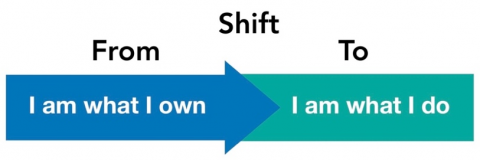
In the experience economy, our priorities for participation in leisure and entertainment experiences have changed. Our dimension of status, self-identity, and social capital measure has shifted from owning envious material goods and stuff to an immaterial means - sharing our experiences on social media. Today, what you do now matters way more than what you own. Today, two-thirds of Americans would rather be known for their experiences than their possessions. Especially for younger adults, an impressive selfie capturing a memorable experience at a unique OOH entertainment venue is as desirable as a new car or fancy watch was to their parents. Conspicuous consumption is out, and conspicuous OOH entertainment experiences are in.
From a consumer perspective, what the experience economy means for OOH entertainment is that the pursuit of experiences has taken on a more prominent role in people's lives than in the past. People use experiences to express who they are and build their identity and status. Experiences are the new social currency.
Social media
The importance of experiences as social currency has been amplified by the adoption and growth of social media. Now you can instantly broadcast your experience on Facebook, Instagram, and other social apps to increase your status. Especially for 20- and 30-somethings, if it isn't Instagrammable, if it isn't sharable, it's probably not worth doing.
This means that once you've participated in some OOH entertainment attraction experience and shared it with your friends and followers on social media, there is no longer any social capital value to repeating it. The experience has been commoditized with just one visit. Instead, you want to move on to new experiences to add to our Experiential CV.
Social media also exposes us to all the OOH experience choices we have. Postings on social media create our desire to participate in as many OOH experiences as possible, to not miss out on anything, known as FOMO (fear of missing out). We want to consume more experiences and do them more quickly so we don't miss out on anything.
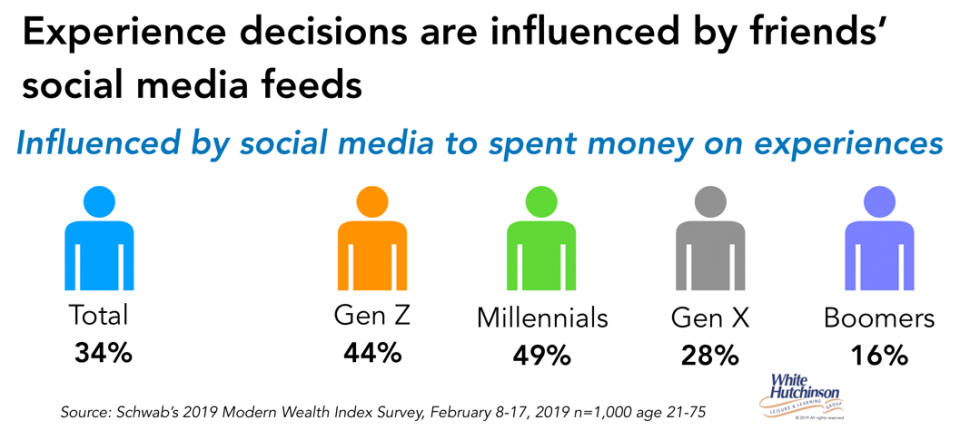
Unlimited OOH options
Another important change from the past is that the OOH entertainment landscape has ballooned in size since the turn of the Century. We now enjoy an almost unlimited choice of different and expanding types of OOH leisure and entertainment, more than anyone can ever do.
Today there are far too many OOH entertainment and cultural venues and experiences (think about all the one-time festivals, concerts, etc.) chasing our limited discretionary leisure time and money.
These are just a few of the many
OOH leisure options people have today
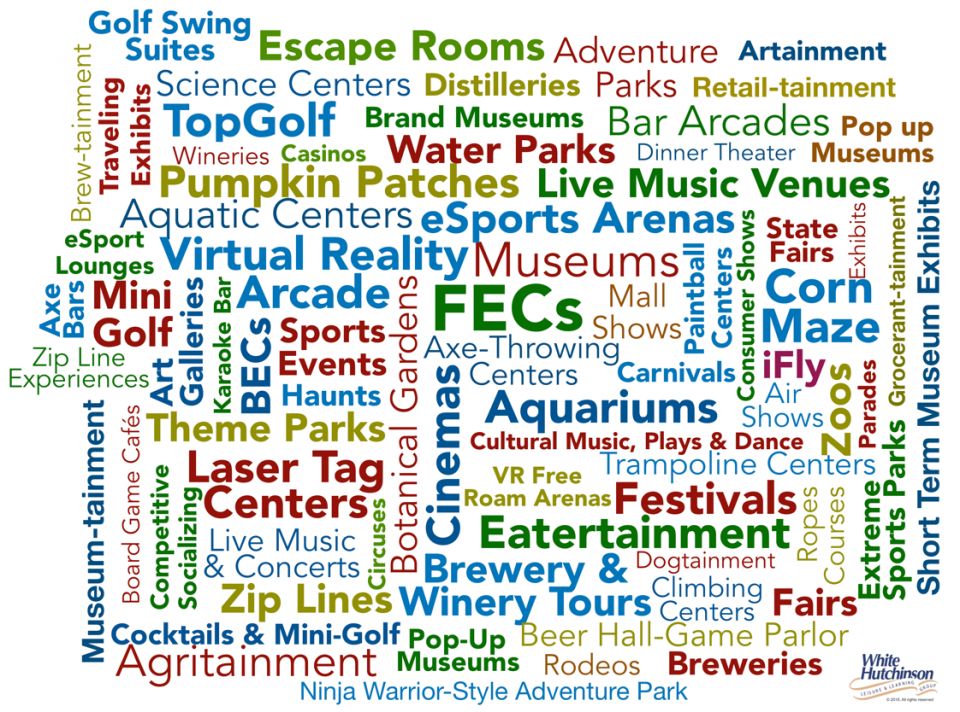
Today people want to enjoy, share, and collect as many different experiences as possible in their limited leisure time, increasing their social capital and bragging rights. Now it's all about a culture of novelty-seeking and the pursuit of new, unique, and sharable OOH experiences, unlimited in supply, with new unique ones added almost daily. Been there, done that; let's move on to collect as many other share-worthy OOH experiences as possible.
Today's highly competitive entertainment landscape includes many more OOH options than just a decade ago and a wealth of new digital at-home and mobile entertainment. With so many other choices competing for our leisure time and discretionary spending, hedonic adaption occurs even faster - been there, done that, moving on to something new as there are so many new options to check out. There's never a lack of new, unique, and share-worthy experiences to move on to. So, today fixed-attraction entertainment venues can't maintain their repeat appeal as in the past. Today, it's an entirely new competitive ballgame. The LBE which relies predominately on fixed attractions has lost its competitiveness.
Leisure time famine
The higher socioeconomic population with the discretionary income to spend on OOH entertainment have the least amount of discretionary leisure time, therefore many people experience leisure time famine - so many things to do and not enough time to do them all. As a result, they want to use their limited leisure time to the fullest, to make it as productive and efficient as possible, so they engage in what is called voracious consumption of leisure, fast-paced and intense participation in multiple types of OOH leisure, what you might call optimization of out-of-home leisure time. Voracious leisure consumption involves a wide variety of OOH leisure activities and a high frequency of participation. One driving force of why the income-rich, time-poor pursue voracious leisure consumption is that being busy is now seen as a marker of social distinction, as a "badge of honor."
Research shows that those harried adults with high social status are generally more highly educated with higher incomes. In addition to cramming more and more different activities into their leisure time (their voraciousness), they also spend more time with their spouse and other adults in social leisure and entertainment experiences than lower-status adults. Voracious consumption of OOH leisure is particularly characteristic of single adults and younger childless couples.
Leisure inequality
What we now have is leisure inequality. It is a bifurcated leisure market, especially regarding OOH entertainment and arts experiences (E&A). Lower-socioeconomic people with the most leisure time can least afford to visit OOH E&A venues. In contrast, the higher-income, generally the higher-educated, can afford OOH E&A experiences. Since the higher income, higher-educated feel the most time-pressured, they voraciously pack the most activities into the leisure time they do have. They spend more time and a higher percentage of their leisure time at OOH E&A venues than the low socioeconomic who have the most leisure time. Adults with bachelor's or higher degrees spend 50% more time at OOH E&A, 2.5% of their total leisure time, compared to high school graduates who have 35% more leisure time but only spend 1.3% at OOH E&A.
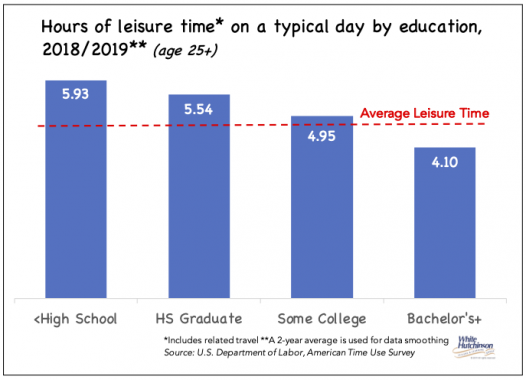
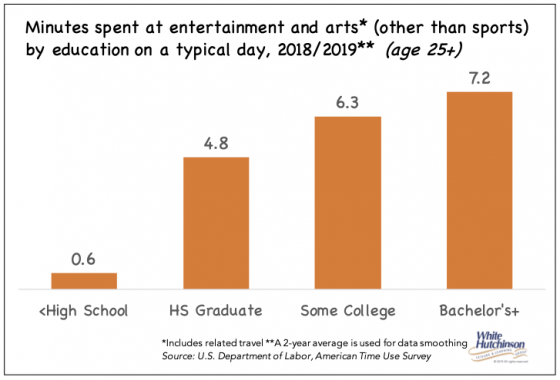
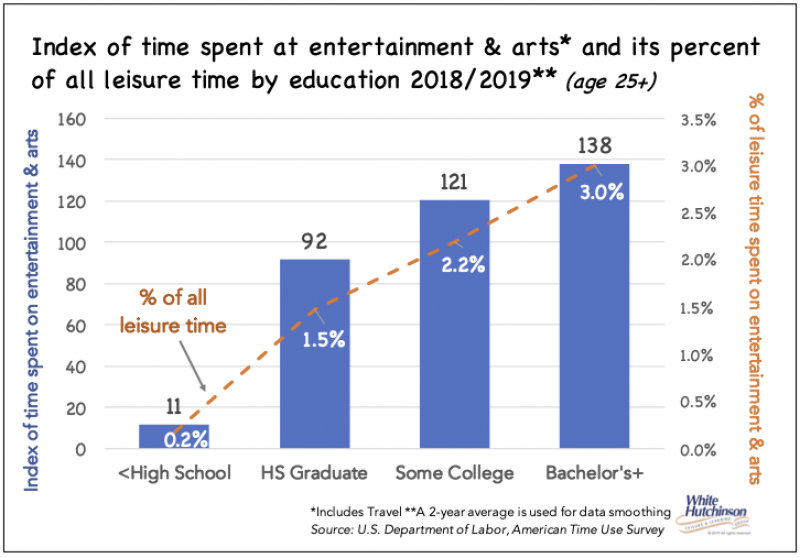
This bifurcated OOH E&A market appears to be borne out by spending data. Bachelor's and higher degreed households, 44% of all households, now account for 71% of all community-based OOH E&A spending on fees and admissions. That's a 50% increase from 47% of all spending back in 2000.
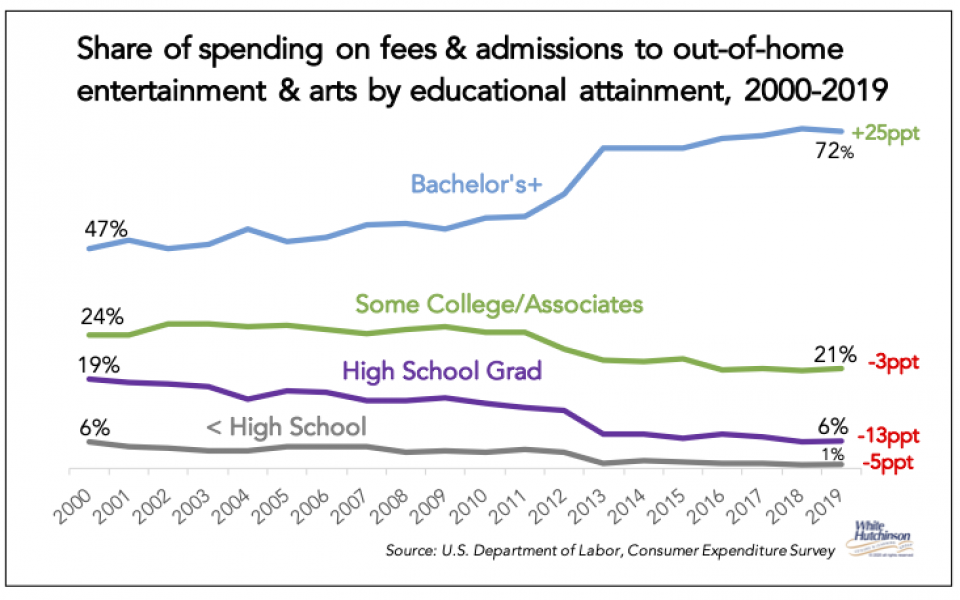
The following graph shows that community-based OOH entertainment has become gentrified, regardless of the type, including two-thirds of all cinema ticket spending (66%), the least expensive OOH entertainment option, by bachelor+ households,.
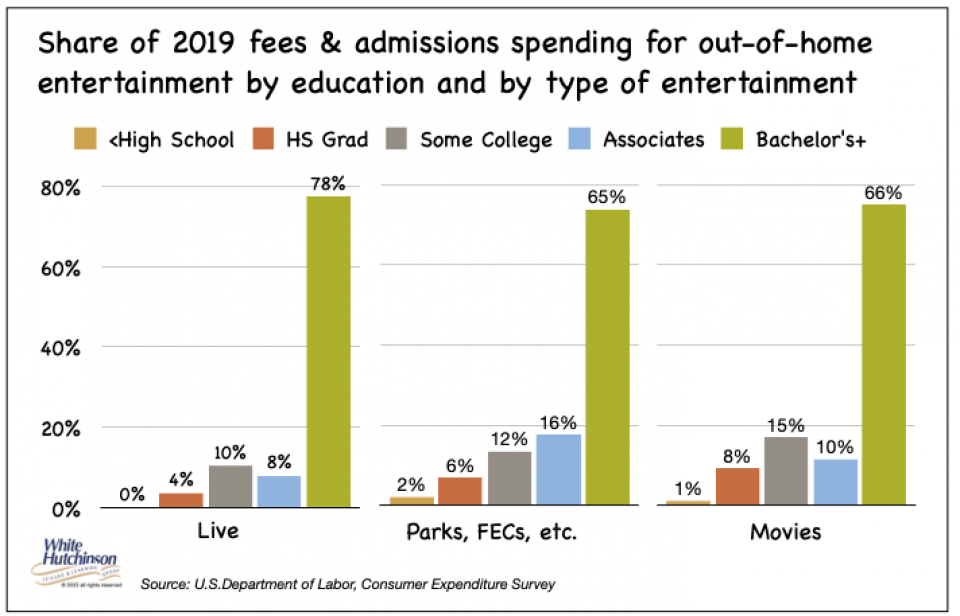
Transformative experiences
The 5 th level of economic value in the progression of economic value - transformative experiences - also contributes to the declining appeal of all types of entertainment attractions. For more Americans, especially the higher educated, the goal of leisure and entertainment is to reach greater self-actualization. Psychologist Abraham Maslow placed self-actualization at the pinnacle of the hierarchy of human needs. According to Maslow, self-actualization refers toman's desire for fulfillment … to become everything that one is capable of becoming."
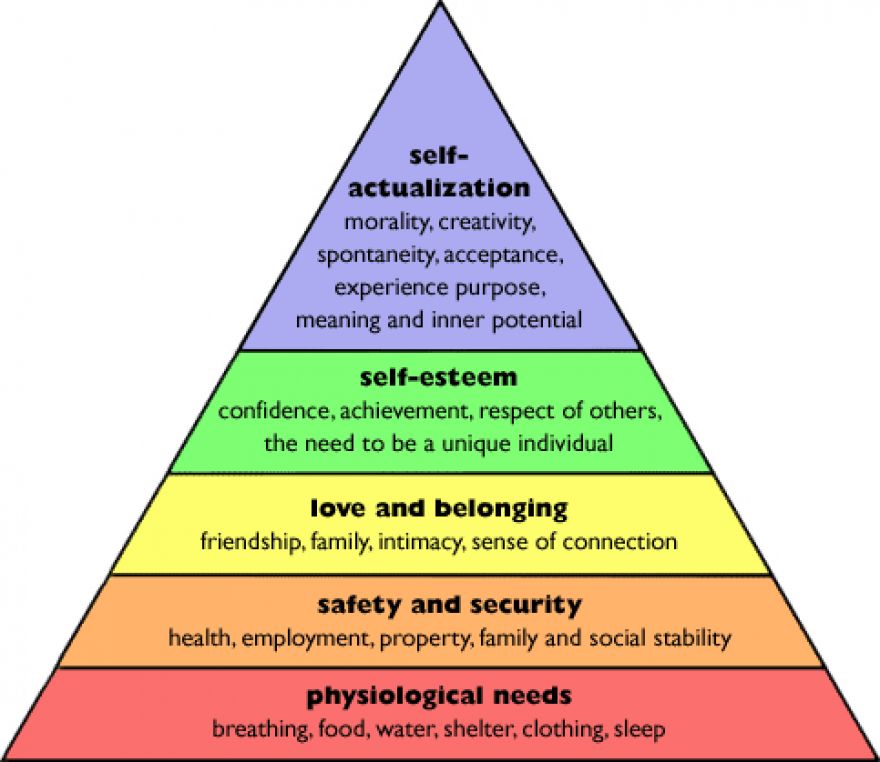
Maslow's Hierarchy of Needs
The 5 th level of the progression of economic value and Maslow's Hierarchy of Needs place the greatest value on the same needs - experiences that make you a better person rather than just buying things or enjoying non-enriching experiences.
In their book The Experience Economy, Joseph Pine and James Gilmore tell us that we are moving into the Transformation Economy in which we desire experiences that are not only enjoyable and create great memories, but that transform and leave us improved in some way.
Transformative experiences enhance the value of invested leisure time, moving the time value from time well spent for entertainment experiences to time well invested for transformative experiences.
There are many transformative experiences. Examples include working out at a gym to be in better physical condition and learning new things of personal interest, such as for a hobby or a cooking class. The popularity of beer, wine, and food festivals has been partially driven by people's desire to discover and learn about foods and drinks.
The bottom line is that many people, especially the higher socioeconomic, the majority of the OOH E&A market, want to collect new experiences rather than repeat them. Been there, done that, already posted on social media, time to move on to something new and maybe transformative. Fixed attraction LBE experiences have lost almost all their repeat appeal except for a small core of loyal fans.
New business model
This commoditization after one visit, this loss of repeat appeal for fixed attraction LBEs, requires a completely new business model. Although fixed attractions that facilitate socialization, such as social games, can still be part of the mix, the mix now requires continually changing programming of live, limited- and one-time events and offerings.
Food and drink
Food and drink have become an important part of the mix due to the rise of the foodie movement and the opportunity to include culinary adventure and discovery as part of the visit experience, as well as to enhance socialization. Various menu offerings, including craveable, seasonal, and other LTOs (limited-time offerings), and unique food and drink experiences help drive repeat appeal.
There is nothing more powerful for repeat appeal than dining out. Americans eat out around four times a week, far more than any type of OOH entertainment. We never get tired of eating, whereas we easily tire of some attraction. In fact, we eat more frequently than in the past, around five times a day when you count snacking.
This is why the eatertainment venues with destination dining and bars combined with highly social gaming options are so successful. The food and beverage accounts for half or more of the revenues and is as much, often more so, a driver of attendance as the attractions. The combination creates a strong synergistic appeal. Interactive social games combined with food and drinks make a great social experience. That is why we are seeing the expansion of what is mistakenly called "competitive socializing" venues (see the article in this issue that discusses the type of social games that work).
The new formula
To overcome the commoditization of LBE experiences, the been there, done that mindset, there needs to be continually changing new and unique reasons to return, ones that are not only enjoyable but IRL social and sharable as social currency. Programming one- and limited-time unique events are just, if not more important, to LBE repeat attendance as the fixed attractions. Elevated pleasurable, fun, and enjoyable food and drink experiences, including LTOs, are now essential to the mix.
Transformational experiences are also important to create repeat attendance. You can turn experiences into transformative experiences by focusing on what your customers aspire to become and how you can help them achieve that.
Many existing LBE operators and entrepreneurs seem not to understand that the leisure and entertainment consumer's preferences, expectations, values, behaviors, and culture have dramatically changed, so you are not dealing with the same person you might have a decade or so ago. A new leisure culture has disrupted the classic FEC and LBE business models and requires a new approach to developing sustainable brick-and-mortar entertainment venues. It will be difficult for many existing LBE and FEC operators to accept and make a major mind shift from the old attraction-based operating paradigm to the new business models that future success now requires.
Subscribe to monthly Leisure eNewsletter


